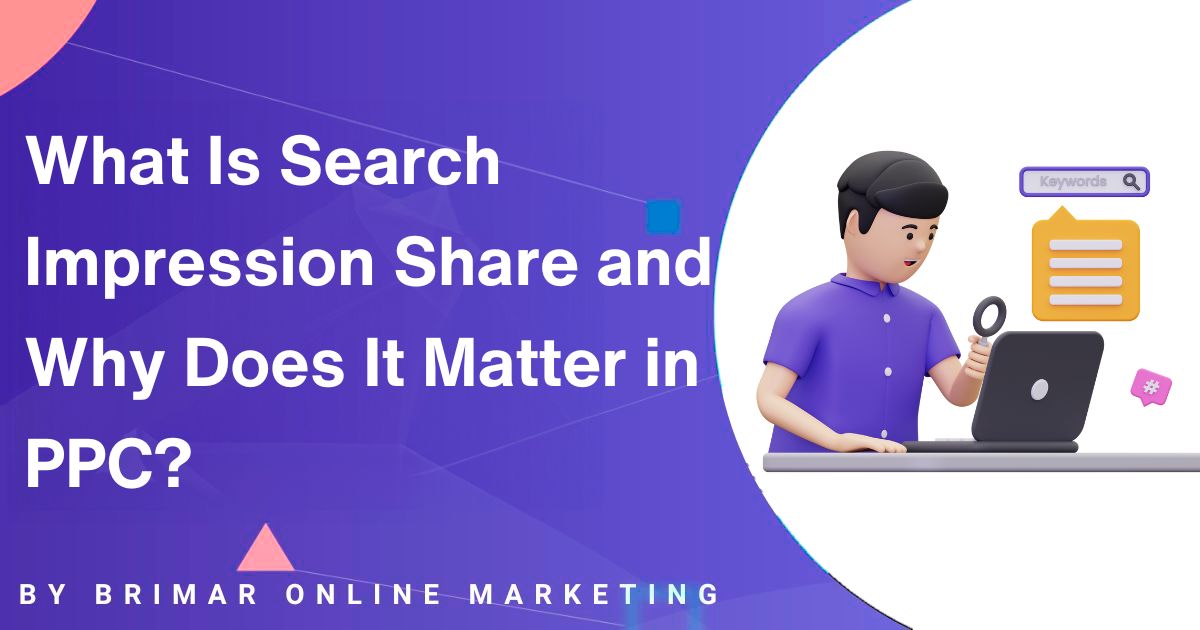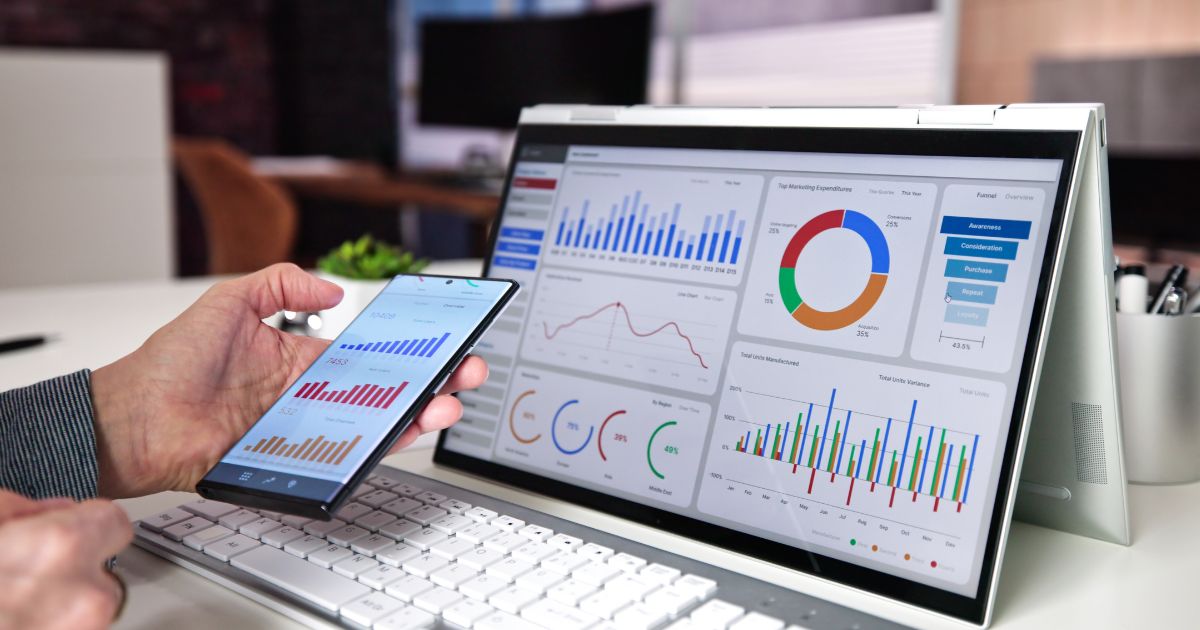
Search impression share is simply the percentage of times your ad appeared compared to the number of times it could have appeared on the search engine results page (SERP).
It tells you how much visibility your ads are getting in the auctions for which you’re eligible.
Why does that matter?
Because more visibility means more chances for your brand to connect with potential customers.
When people see your ad more often, and in better positions, you’re not just increasing clicks, you’re strengthening brand awareness and giving yourself more opportunities to convert.
Whether you’re running search ads, display ads, or shopping campaigns, your impression share directly impacts the profitability of your campaigns.
If it’s low, you’re leaving potential customers (and revenue) on the table.
What is Search Impression Share
Impression share measures what percentage of the total available impressions your ads capture.
For instance, if your ads had the potential to appear 1,000 times but only appeared 600 times, your impression share would be 60%.
Let’s break it down:
- Total impressions refer to the number of times your ad appeared.
- Total eligible impressions are all the times your ad could have appeared if there were no limitations (like budget or ad rank).
- The remaining “available impressions” or “potential impressions” are the ones you didn’t capture, those are opportunities waiting to be claimed.
In Google Ads (formerly Google AdWords), this metric is calculated automatically and displayed right inside your account.
You can find impression share data at three levels: campaign, ad group, and keyword.
Looking at all three gives you a complete picture of how well your ads are competing in different areas of your account.
A higher impression share generally signals that your ads are performing well, that your campaigns are competitive, and that your budget and bidding strategy are aligned with your goals.
Alongside impression share, Google also provides competitive metrics and auction insights, which help you see how your ads compare to those of your competitors.
These insights are invaluable for figuring out what’s holding your ads back and where you can make improvements.
Start Attracting Customers Through PPC Advertising Today!
We can help you create PPC campaigns that attract customers. Our services include bid management, keyword management, landing page performance reviews, and more.
Different Types of Impression Share Metrics
Not all impression share metrics are the same.
The way you measure and interpret them depends on your campaign type and the goals you are pursuing.
For search campaigns, you’ll often look at search impression share, which tells you how often your search ads appeared compared to the total possible appearances.
For display campaigns, the equivalent metric is display impression share, which measures visibility across Google’s Display Network.
For shopping campaigns, impression share helps you understand how visible your product listings are compared to competitors.
There are a few key metrics you’ll want to pay attention to:
- Search impression share: The baseline measure of how much visibility your ads are getting in search results.
- Display impression share: Same concept, but for display ads on websites, apps, and YouTube.
- Absolute top impression share: This shows how often your ads appeared in the very first position on the SERP, valuable real estate.
- Exact match impression share: Focuses on how often your ad showed when the user’s search term matched your keyword exactly.
- High search impression share. Your campaigns are robust and competitive, but a low search impression share suggests missed opportunities.
Several factors can influence these numbers.
Your ad formats, ad extensions, and even the approval statuses of your ads all play a role in how often and where your ads appear.
For example, high-quality ad extensions can enhance your visibility, while disapproved ads or limited formats can hinder your progress.
By monitoring these different metrics, you can identify where your campaigns are performing well and where you need to optimize, whether it’s adjusting budgets, refining ad copy, or improving your bidding strategy.
Why Does Impression Share Matter?

Impression share is a window into how often your ads show up when they could have.
If you’re aiming to stay visible to your potential customers, you can’t ignore it.
The higher your impression share, the more likely your ads will appear at the top of the search engine results page.
That visibility directly feeds into stronger ad performance and better ad quality, as it signals that you’re competing effectively in the auction.
When your impression share drops, it’s often a sign that something needs to be fixed.
Low impression share usually comes from an insufficient budget, tight budget constraints, or a low ad rank.
If you’re not bidding competitively or if your ads aren’t relevant enough, you lose valuable impressions to competitors.
Improving your quality score, writing more relevant ad copy, and ensuring your landing page provides a good user experience can dramatically increase your impression share.
This also helps you climb closer to the absolute top position, where clicks and conversions are much more likely.
When your ads show more often , and in better positions, you’re not just visible; you’re engaging the right audience, which improves your click-through rate and conversion rate at the same time.
Factors That Affect Impression Share
Several moving parts determine how many of the available impressions you capture.
Your campaign budget, daily budget, and overall PPC budget are foundational.
If your budget is too small for your audience size or level of competition, you’ll see a low impression share, regardless of how good your ads are.
Bidding strategy also plays a big role.
Since Google Ads runs on an auction system, marginal cost and how much you’re willing to pay for visibility influence whether you win more auctions.
You don’t always need to bid the highest, but you do need a strategy that balances cost and competitiveness.
The structure of your campaigns matters too.
Strong, focused ad groups and well-organized product groups help you pair the right keywords with the right ads.
Using relevant keywords at the keyword level ensures you’re targeting what your audience is searching for.
Being deliberate with match types also proves beneficial.
Broad match keywords can yield more impressions, but often with less relevance.
Exact match gives tighter control and more qualified traffic, but at a smaller scale.
Finding the right balance depends on your goals and the search terms you want to capture.
Finally, pay attention to where you optimize: the ad group level gives you more control over specific segments, while campaign level changes impact everything under that campaign.
Both have their place, and the key is knowing when to zoom in or out.
How to Improve Your Impression Share

If your impression share is low, don’t panic; there are proven ways to turn it around.
Start by allocating your ad budget strategically.
If budget constraints are holding you back, focus your spending on your highest-performing campaigns or keywords to maximize visibility where it matters most.
Improving your ad copy and landing page experience can enhance your ad rank, making you more competitive without the need to raise bids continually.
Small changes, like clearer headlines, faster-loading pages, and more compelling calls to action, add up to better results.
One of the simplest ways to target specific visibility goals is to use the target impression share bidding strategy.
This tells Google exactly how much coverage you want, and the system adjusts bids to meet it.
Higher quality scores also go a long way.
They signal to Google that your ads are relevant and valuable, which means you can show more often, sometimes even at a lower cost.
Experimenting with various keywords, ad formats, and messages will help identify what appeals most to your audience.
For local businesses competing in tight markets, narrowing your targeting to specific locations, utilizing relevant ad extensions, and focusing on high-intent search terms can help you achieve a high search impression share without overspending.
In short, improving impression share isn’t about doing one big thing; it’s about making smart, consistent tweaks across your campaigns to claim more of the visibility you deserve.
Impression Share Across Networks
Search and display networks don’t work the same way, and understanding how impression share behaves on each can help you use your budget more wisely.
On Google’s search network, your ads are shown next to search results when users enter relevant keywords.
Here, your impression share reflects how often your ads show up compared to the total eligible impressions for those search terms.
This is what most people think of when they hear “search impression share,” and it’s closely tied to factors like your ad rank, keyword match type, and bidding strategy.
The display network, on the other hand, shows your ads across millions of websites, apps, and videos.
This network reaches people as they browse content rather than actively searching.
As a result, display impression share tells a slightly different story: it measures your visibility across all available display placements.
Search ads and display ads offer different types of visibility.
Search impressions typically reach users at the moment they’re looking for something specific, a clear signal of intent.
Display impressions tend to focus on building awareness and keeping your brand top of mind as people go about their daily activities.
Both have their place, but understanding how impression share behaves in each context helps you decide where to focus, especially if your budget is limited.
Impression Share. A Key Performance Indicator

Impression share is one of those metrics that quietly carries significant weight.
It tells you not just how often your ads show up, but how competitive you are in the auction and how much room you have to grow.
That’s why it’s a key performance indicator (KPI) for online advertising.
Tracking your impression share provides valuable insights into how effectively your ads are reaching your target audience.
If your share is low, you may have a low ad rank, an insufficient budget, or need to refine your ad copy and landing page experience.
If it’s high, it usually signals that you’re reaching more of the potential customers available to you, a sign that your ad campaigns, ad groups, and bidding strategy are working together effectively.
It also assists in aligning your PPC ads with your overall objectives.
For instance, if building brand awareness is the priority, you might aim for a higher impression share on the display network to maximize reach.
If conversions are the focus, maintaining a strong share in search campaigns with high-intent keywords becomes increasingly essential.
When you watch these metrics closely, you can spot trends, address gaps, and make smarter decisions.
Final Thoughts
Monitoring your Google Ads impression share isn’t just a good idea, it’s often the first step toward improving results.
Seeing where you stand gives you the context you need to adjust your budget, refine your bidding strategy, and even rework your ad groups or campaign types.
It’s worth taking the time to dig into your impression share data, test different campaigns, and experiment with strategies to improve.
You’ll likely find opportunities to increase visibility, attract more of your target audience, and make better use of your ppc budget without overspending.
At its core, impression share isn’t just about showing up more often.
It’s about understanding how visible you are to the right people at the right moments, enhancing ad performance, and increasing campaign profitability.
By paying attention to this metric, you put yourself in a much stronger position to reach your goals and connect effectively with your potential customers.
Our PPC Services Have Helped Our Clients Increase Their Revenue!
“I highly recommend Brimar if your looking to grow your online business. You will be satisfied with the high level of expertise and high quality of services. It has helped my business grow by leaps and bounds.”
CEO
